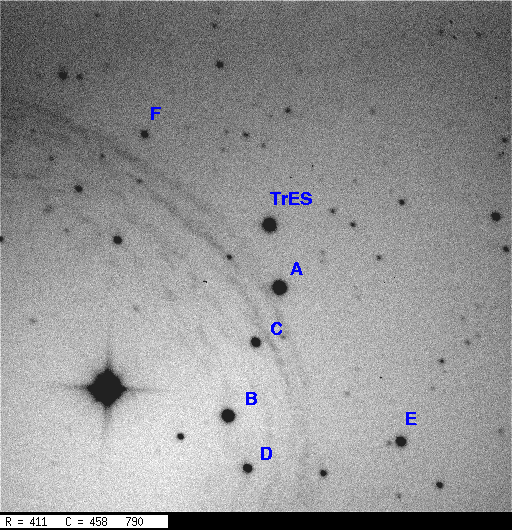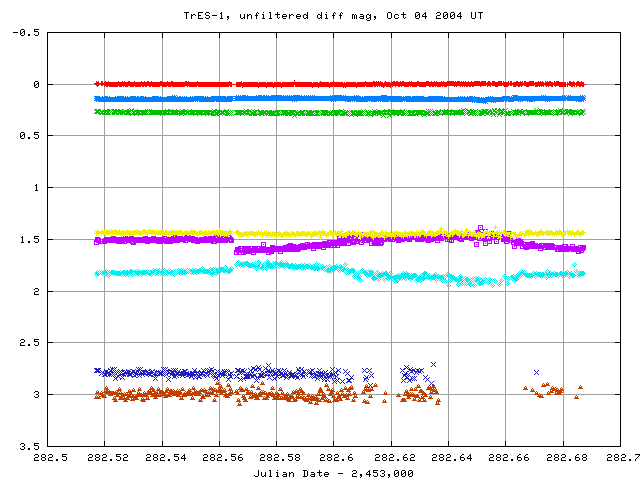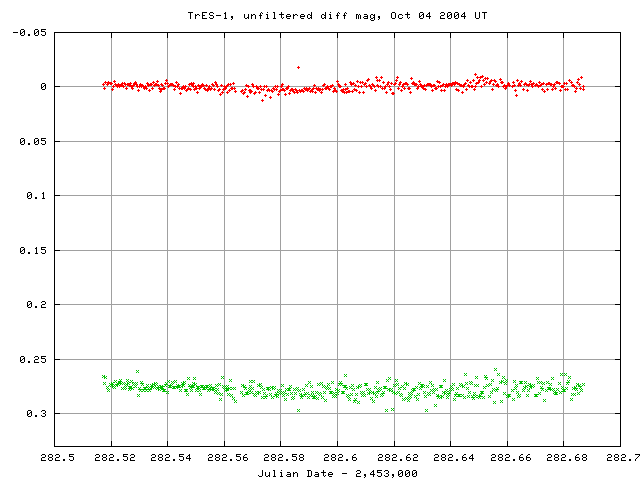
On the night of Oct 03/Oct 04, 2004 EDT, I used the RIT Observatory's 16-inch Cassegrain telescope and SBIG ST9 CCD camera to observe the star TrES-1, which is known to have a planet which causes transits.
The plan:
Notes from the night
Here's a chart of the field of TrES-1 from one of the pictures taken this night. It's rotated 180 degrees from the usual manner: North is down and East to the right. The field is about 10 arcminutes wide.

Note the nasty gradient across the frame, plus the wierd arc-like features in the lower-left quadrant. I don't know what causes them, but they run through several stars. I don't know if the arcs would disappear after flatfielding. They are clearly bad news, as the photometry below will show.
I measured the instrumental magnitude of each star with aperture photometry, using a radius of 8 pixels = 5.6 arcseconds, and sky defined by an annulus around each star. Following the procedures outlined by Kent Honeycutt's article on inhomogeneous ensemble photometry, I used all stars available in each image to define a reference frame, and measured each star against this frame.
(I also tried using a large aperture of radius 10 pixels, but the systematic errors in the light curves of stars C and D became worse).
Below is a graph of the scatter in differential magnitude versus magnitude. Note that the brightest stars included in the solution may be slightly saturated. I made a series of preliminary solutions and discarded stars which had large scatter due to close companions, or due to their position near the edge of the frame, etc.

TrES-1 has differential mag 0.28; it's the third-brightest star in the graph. It does not stand out above the other bright stars in the field. The two stars between differential mags 1 and 2 with large scatter are C and D; you'll see why below.
Light curves for selected stars in the field are shown below. TrES-1 is in green.

The stars C (purple) and D (aqua) undergo big shifts which I believe are most to a changing FWHM. I refocused just after JD 282.56, leaving a small gap you can see, so that the FWHM was about 3.8 pixels. But as the night continued, the temperature dropped, and the FWHM rose steadily to about 5.5 pixels by the night's end. Clouds increased, too, until they cleared at the end of the night. It's clear that aperture photometry without flatfielding in these poor conditions has serious flaws ....
I was thinking that perhaps TrES-1 might show gradual, small variations due to spots on its surface. Let's look more closely at TrES-1 (green) and star A (red):

Nope, no significant variations appear in TrES-1, at least not to my eye. The formal standard deviation of differential magnitudes from the mean of TrES-1 is 0.005 mag, compared to 0.003 mag for star A and 0.005 mag for star B.
Conclusion: I'm giving up (for now) on the idea that the asymmetry in the transit light curves of TrES-1 might be due to big spots on its photosphere.
Last modified 10/17/2004 by MWR.